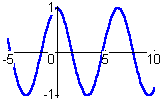Sinusoidal Graphs
Part 1:
Period
In this module we study properties of the graphs of the two most basic
trigonometric functions, sine and cosine.
The first graph we'll study is the sine graph. Since its shape occurs
in so many graphs of natural phenomenon, it has spawned its own
adjective: A sinusoidal curve is one that fluctuates back
and forth like the sine graph.
- Plot the sine curve defined in your worksheet,
and note the fluctuations. A function whose graph fluctuates in a
repeating pattern is said to be periodic. The graphs of three functions are shown below. One of the functions is not periodic, and the other two are. Which one is not periodic?
- Only one of the three graphs above is sinusoidal -- which one?
- The period of a periodic function is the shortest distance along the horizontal axis at which the graph starts to repeat. Estimate the period for each of the two periodic functions whose graphs are shown above.
- For the sine function whose graph is in your worksheet, explain why the period is the distance from one peak to the next.
- To find the period of the sine function, let's locate the t values that give the graph its
maximums -- that is, the solutions of sin(t) = 1. Use your helper application to solve the equation sin(t) = 1 in some appropriate range. You may find only one t value at a time, so vary your guessing range until you have determined the t values for all the maximums you see on the graph. (Hint: Express
these values in terms of pi!) What is the period of the sine function? Express your answer in terms of pi.
- The next plotting command in your worksheet graphs the function sin(Ct), where C is set to 3. Plot the function, and determine its period.
- Vary the value of C, and determine how the period is related to this
value. (You might have to change the domain or the size of the graph box to see
the peaks better.) What do you conclude about the period of sin(Ct)?


